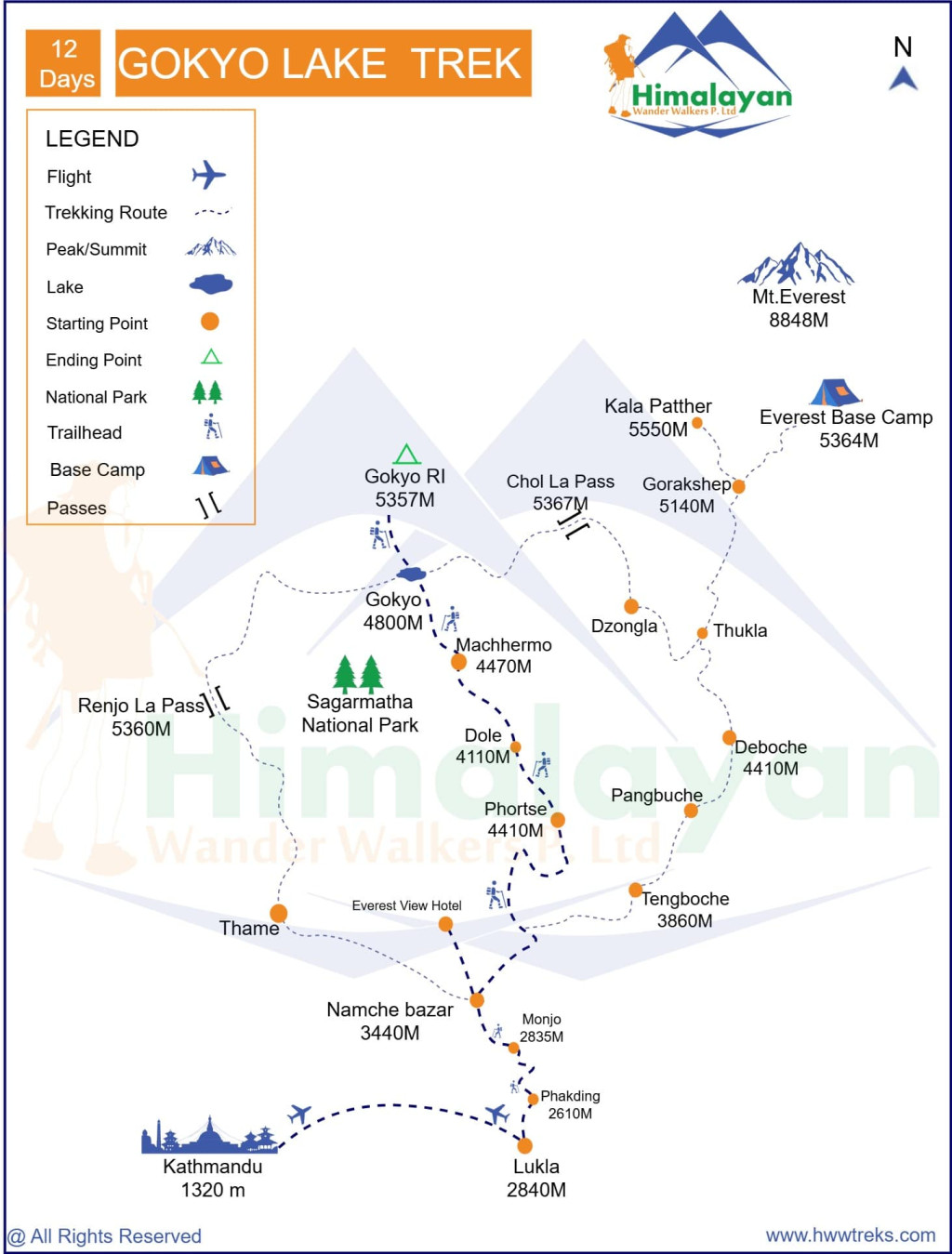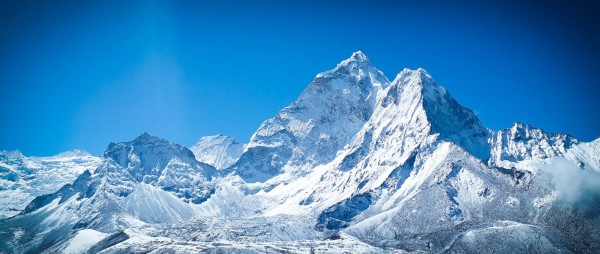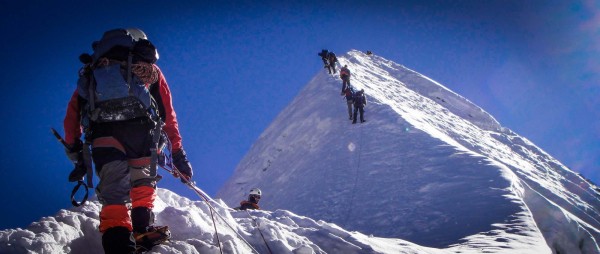Important Information
Region
Everest Region Trek
Duration
12 Days
Max Altitude 5360 meters
Best Season March, April, May and September, October, November
Activity Per Day
Itinerary
Grade
Level 3
Group Size
2 - 12 people
Transportation 2 way Flight
“Gokyo lake trek is the perfect destination in the Everest region for those who detest crowds and expect jaw-dropping scenery”
Gokyo lake trek is the second most popular destination in Everest Region which offers an alternative to the traditional trek to Everest base camp. The view of the Gokyo region is incredible. The trekking trail follows the Everest base camp route to Sanasa, next to the tea house place from Kangjuma after leaving Namche Bazar. Then the trail continuously goes through the left side of the Dudh Koshi River to its source, a couple of lakes, and Ngozumpa Glacier. Gokyo village (4750m) is a more satisfying destination than Gorak Shep, a proper Sherpa village with a huge herd of Yaks. Gokyo RI (5360m) is sometimes also called Kala Pattar because it offers a breathtaking panoramic view of Everest, Lhotse, Cho Oyu, Makalu, and mesmerizing three sacred lakes (Dudh Pokhari, Taujung Tso, and Longpongma Tso).
Most of the trekkers want to include Gokyo Lake in their itineraries whether they are trekking to Everest base camp or doing three passes because of its amazing scenery.
If you are looking for a different itinerary than the itinerary here, please Customize Your Trip.
Highlights of the Gokyo Valley Trek
- Gokyo Ri features the panoramic view of Cho Oyu, Everest, Lhotse, Makalu, Cholatse, and Taboche with the Ngozumpa Glacier.
- The sacred lake of six languid pools that surround Gokyo.
- You will see the herd of yak and mountain goat grazing over the hills and mountains.
Include
All airport pick-up & drop by private vehicle (international and domestic)
Kathmandu-Lukla-Kathmandu flight including airport tax
National Park entrance fee and Trekkers’ Information Management System (TIMS card)
English speaking, government licensed guide with all his salary, food, drinks, accommodation, transport and insurance
Twin/double sharing accommodation in the mountain during the trekking
Three meals a day; breakfast, lunch, and dinner during the trek
First aid kit
Arrangement of emergency evacuation service (should have insurance for emergency evacuation and will be paid by your travel insurance company)
trekking route maps
All necessary government taxes and service charges
Porter (For two-person)
Exclude
Your Nepal visa fees and 2 passport size photos
All the International airfare from and to Kathmandu
All meals and Accommodation/ hotels in Kathmandu
Food and accommodations in case of early arrivals from the trek or late departures from the airport
Your extra personal expenses during trek such as (laundry, baggage charge, phone calls, battery recharge, bar and beverage bill, boiled or bottled water, hot and cold shower, extra porter, etc)
Tips for the trekking crew
Extra expenses due to flight delays, strikes, weather condition or any event out of our control
Route Map

Important Information
CHECKLISTS FOR GOKYO LAKE TREK
- Valid passport (valid for six months from the date of your trip)
- MasterCard, Visa Credit, and Debit Cards are accepted in Nepal. However, some cash is highly recommended.
- Mobile (if your cell phone is from CINGULAR USA or ATNT (USA) operators, then your cell phone will work in Nepal.)
- Clothing (Layered clothes, windproof and waterproof jackets, fleece pullovers, thermal base layers, hiking pants, shorts, headwear, footwear, and other items according to your needs)
- Personal Items and Toiletries (First-Aid Kit, Iodine tablets or a UV purifier to treat water, Sun Protection)
- Travel and Health Insurance
- Trekking gear and equipment(if you have your own trekking gear and equipment, such as trekking poles, sleeping bag, and shoes, then you can bring them; else you can rent them in Thamel, Kathmandu). Read more for trekking gears and peak climbing gears.
Guiding, Food, and Lodging
In Nepal, all trekking supplies - Teahouse trekking means staying and eating in local lodges. We stay in single rooms where possible, but often you will have to share. Rooms are basic, normally just a bed with a pillow, blankets. A few have electric lights and all have a spacious dining room-lounge. We eat at teahouses and, although the food is usually plentiful and delicious, the menu is not extensive. They offer a variety of potatoes, rice and noodle dishes, as well as soup and seasonal vegetables. Beers and local spirits are often available, but that will be at your own cost. A variety of cereals, bread, and egg dishes are generally available for breakfast. There are also snacks available such as basic biscuits, chocolate, and soft drinks and in some areas, you will find fresh fruit in season. It is normal to meet your porter in the teahouse where you will stay overnight. So, pack your necessary things in your own day pack.
DRESS CODE FOR VISITING MONASTERIES, AND TEMPLES IN NEPAL
- Shirt (either half or full sleeve)
- Full pants/long skirts
- Any type of shoes with socks
- No Hats, No Umbrella, No Slippers, No t-shirts, No short skirt, and No half-pants
- Photographs allowed in the courtyard only.
Note regarding itineraries
Although we generally adhere to the schedule, the itinerary is subject to change for numerous reasons beyond our control, including weather and terrain conditions, suitable campsite availability, and the group's general fitness level. It is important to understand that our trek is logistically complex and it is not unusual that adjustments be made. Our guide will orient you each evening to the following day's plan; their good judgment is the key to the long history of successful treks that Himalayan Wander Walkers has led till now. Please remember that our ability to make adjustments as needed helps to ensure that your trek is successful.
Frequently Asked Question
Absolutely! You can tailor your Gokyo Lakes Trek according to your preferences. Whether you’d like to shorten, extend, or modify the route to include additional rest days or specific destinations, we’re happy to accommodate your requests. If you want to visit certain villages, monasteries, or scenic spots along the way, just let us know, and we’ll design a trip that suits your desires. Simply mention, "Customize Your Trip.”
The Gokyo Lakes Trek is rated as moderately challenging, with the main difficulty stemming from the high-altitude environment. It requires a good level of physical fitness and stamina, as the trek reaches up to 5,357 meters at Gokyo Ri. Acclimatization is essential to minimize the risk of altitude sickness. Gradual ascent and proper preparation are key.
Yes, hiring a guide for the Gokyo Lakes Trek is highly recommended. The route traverses remote and rugged terrain, and having a guide ensures safety, smooth navigation, and proper acclimatization. Guides also offer valuable cultural insights and can assist with unforeseen challenges, such as weather disruptions or delays in Lukla flights.
Yes, you will need two important permits: the Everest National Park Entry Permit and the Khumbu Pasang Lhamu Rural Municipality Entry Permit.
Yes, altitude sickness is a potential concern, especially since the trek reaches altitudes above 5,000 meters, particularly at Gokyo Ri (5,357 m). To mitigate this risk, the itinerary includes rest days at lower elevations such as Namche Bazaar (3,440 m) and Gokyo (4,750 m). Ensuring proper hydration, nutrition, and gradual ascent are critical to preventing altitude sickness. If any symptoms like headaches, dizziness, or nausea arise, promptly inform your guide for immediate action.
Throughout the trek, you'll stay in comfortable teahouses and lodges. These offer simple yet cozy rooms and local meals, providing an immersive cultural experience as you journey through the region.
Yes, limited internet access is available along the Gokyo Lakes Trek. Mobile coverage from networks like Ncell and NTC is present, and several lodges offer Wi-Fi. Everest Link provides prepaid wireless broadband services in some locations.
Essential items to pack include durable trekking shoes, warm clothing, a sleeping bag, water bottles, sunscreen, a hat, energy bars, and a small first-aid kit. Aim to pack lightly but efficiently, ensuring you're prepared for varying weather conditions throughout the trek.
Yes, there are several alternatives in the Everest region. The Everest Base Camp Trek offers breathtaking views of Mount Everest and its surrounding peaks. For a more challenging adventure, the Three Passes Trek takes you across three high-altitude passes, providing incredible Himalayan vistas. Both treks offer unique experiences and are worth considering based on your time and level of fitness.
No questions found matching your search. Try different keywords or browse all questions above.
| {{type.min}} - {{type.max}} Pax {{type.name}} - {{type.desc}} | {{type.display_price}} per people |
Extra prices:
Let us help you decide Inquiry
You might also like

- 14 days
- Everest Region Trek
Everest Base Camp Trek
Everest Base Camp Trek is the ultimate goal of many people (bucket list) and those who have already been there; they rate it as one of the best experiences of their life. Everest Base Camp Trek is an iconic trekking destination in the Himalayas and probably in the world. The world's...



